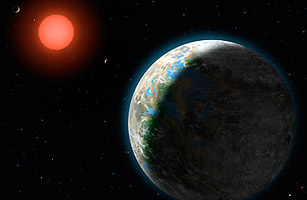
The star known as Gliese 581 is utterly unremarkable in just about every way you can imagine. It’s a red dwarf, the most common type of star in the Milky Way, weighing in at about a third of the mass of the sun. At 20 light years or so away, it’s relatively nearby, but not close enough to set any records . You can’t even see it without a telescope, so while it lies in the direction of Libra, it isn’t one of the shining dots you’d connect to form the constellation. It’s no wonder that the star’s name lacks even a whiff of mystery or romance.
But Gliese 581 does have one distinction — and that’s enough to make it the focus of intense scientific attention. At last count, astronomers had identified more than 400 planets orbiting stars beyond the sun, and Gliese 581 was host to no fewer than four of them — the most populous solar system we know of, aside from our own. That alone would make the star intriguing. But on Wednesday, a team of astronomers announced that it had found two more planets circling the star, bringing the total to six. And one of them, assigned the name Gliese 581g, may be of truly historic significance. .
“We’re pretty excited about it,” admits Steve Vogt of the University of California at Santa Cruz, a member of the team, in a masterpiece of understatement. “I think this is what everyone’s been after for the past 15 years.”
Planetary scientist James Kasting of Penn State University, who wasn’t involved with the discovery, agrees. “I think they’ve scooped the Kepler people,” he says, referring to the telescope that launched into space early last year on a mission to determine how common Earthlike planets might be. The “Kepler people” have a number of candidate Earths in the can but are still working to confirm them.
Being first isn’t the main reason Vogt is excited, however. “Someone had to be first,” he says. “But this is right next door to us. That’s the big result.” What’s particularly big about it is a matter of simple arithmetic. With only 116 stars closer to Earth than this one, it was hardly a sure thing that so small a sample group would produce two habitable planets, including Earth. And two such planets may be an undercount, Vogt says, since just nine out of those 100-plus stars have been studied in any detail. Indeed, one of Gliese 581g’s sister planets, known as Gliese 581d